Amphiprioninae
| Anemonefish | |
|---|---|
 | |
| Ocellaris clownfish, Amphiprion ocellaris | |
| Scientific classification | |
| Kingdom: | Animalia |
| Phylum: | Chordata |
| Subphylum: | Vertebrata |
| Class: | Actinopterygii |
| Order: | Perciformes |
| Family: | Pomacentridae |
| Subfamily: | Amphiprioninae |
| Genera | |
_in_Heteractis_magnifica_(Sea_anemone).jpg)

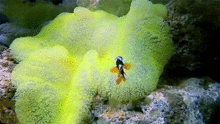
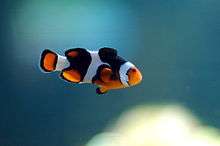

Clownfish or anemonefish are fishes from the subfamily Amphiprioninae in the family Pomacentridae. Thirty species are recognized: one in the genus Premnas, while the remaining are in the genus Amphiprion. In the wild, they all form symbiotic mutualisms with sea anemones. Depending on species, anemonefish are overall yellow, orange, or a reddish or blackish color, and many show white bars or patches. The largest can reach a length of 18 centimetres (7.1 in), while the smallest barely achieve 10 centimetres (3.9 in).
Distribution and habitats
Anemonefish are native to warmer waters of the Indian and Pacific oceans, including the Great Barrier Reef and the Red Sea. While most species have restricted distributions, others are widespread. Anemonefish live at the bottom of shallow seas in sheltered reefs or in shallow lagoons. There are no anemonefish in the Atlantic.[1]
Diet
Anemonefish are omnivorous and can feed on undigested food from their host anemones, and the fecal matter from the anemonefish provides nutrients to the sea anemone. Anemonefish primarily feed on small zooplankton from the water column, such as copepods and tunicate larvae, with a small portion of their diet coming from algae, with the exception of Amphiprion perideraion, which primarily feeds on algae.[2][3] They may also consume the tentacles of their host anemone.[4]
Symbiosis and mutualism
Anemonefish and sea anemones have a symbiotic, mutualistic relationship, each providing a number of benefits to the other. The individual species are generally highly host specific, and especially the genera Heteractis and Stichodactyla, and the species Entacmaea quadricolor are frequent anemonefish partners. The sea anemone protects the anemonefish from predators, as well as providing food through the scraps left from the anemone's meals and occasional dead anemone tentacles. In return, the anemonefish defends the anemone from its predators, and parasites.[5][6] The anemone also picks up nutrients from the anemonefish's excrement, and functions as a safe nest site.[7] The nitrogen excreted from anemonefish increases the amount of algae incorporated into the tissue of their hosts, which aids the anemone in tissue growth and regeneration.[3] It has been theorized that the anemonefish use their bright coloring to lure small fish to the anemone,[8] and that the activity of the anemonefish results in greater water circulation around the sea anemone.[9] Studies on anemonefish have found that anemonefish alter the flow of water around sea anemone tentacles by certain behaviours and movements such as "wedging" and "switching." Aeration of the host anemone tentacles allows for benefits to the metabolism of both partners, mainly by increasing anemone body size and both anemonefish and anemone respiration.[10]
There are several theories about how they can survive the sea anemone poison:
- The mucus coating of the fish may be based on sugars rather than proteins. This would mean that anemones fail to recognize the fish as a potential food source and do not fire their nematocysts, or sting organelles.
- The coevolution of certain species of anemonefish with specific anemone host species and may have acquired an immunity to the nematocysts and toxins of their host anemone. Experimentation has shown that Amphiprion percula may develop resistance to the toxin from Heteractis magnifica, but it is not totally protected, since it was shown experimentally to die when its skin, devoid of mucus, was exposed to the nematocysts of its host.[11]
Anemonefish are the best known example of fish that are able to live among the venomous sea anemone tentacles, but there are several others, including juvenile threespot dascyllus, certain cardinalfish (such as Banggai cardinalfish), Bucchich's (or anemone) goby and juvenile painted greenling.[12][13][14]
Reproduction
In a group of anemonefish, there is a strict dominance hierarchy. The largest and most aggressive female is found at the top. Only two anemonefish, a male and a female, in a group reproduce through external fertilization. Anemonefish are sequential hermaphrodites, meaning that they develop into males first, and when they mature, they become females. If the female anemonefish is removed from the group, such as by death, one of the largest and most dominant males will become a female. The remaining males will move up a rank in the hierarchy.
Anemonefish lay eggs on any flat surface close to their host anemones. In the wild, anemonefish spawn around the time of the full moon. Depending on the species, anemonefish can lay hundreds or thousands of eggs. The male parent guards the eggs until they hatch about six to ten days later, typically two hours after dusk.[15]
Parental investment
Most anemonefish are protandrous hermaphrodites, meaning they alternate between the male and female sexes at some point in their lives. Anemonefish colonies usually consist of the reproductive male and female and a few juveniles, who help tend the colony.[16] Although multiple males co-habit an environment with a single female, polygamy does not occur and only the adult pair exhibit reproductive behavior. However, if the largest female dies, the social hierarchy shifts with the breeding male exhibiting protandrous sex reversal to become the breeding female. The largest juvenile will then become the new breeding male after a period of rapid growth.[17] The existence of protandry in anemonefish may rest on the case that non-breeders modulate their phenotype in a way that causes breeders to tolerate them. This strategy prevents conflict by reducing competition between the males for one female. For example, by purposefully modifying their growth rate to remain small and submissive, the juveniles in a colony present no threat to the fitness of the adult male, thereby protecting themselves from being evicted by the dominant fish.[18]
The reproductive cycle of anemonefish is often correlated with the lunar cycle. Rates of spawning for anemonefish peak at approximately the first and third quarters of the moon. The timing of this spawn means that the eggs will hatch around the full moon or new moon periods. One explanation for this lunar clock is that spring tides produce the highest tides during full or new moons. Nocturnal hatching during high tide may reduce predation by allowing for a greater capacity for escape. Namely, the stronger currents and greater water volume during high tide protects the hatchlings by effectively sweeping them to safety. Before spawning, anemonefish exhibit increased rates of anemone and substrate biting, which help prepare and clean the nest for the spawn.[17]
In terms of parental care, male anemonefish are often the caretakers of eggs. Before making the clutch, the parents often clear an oval sized clutch varying in diameter for the spawn. Fecundity, or reproductive rate, of the females usually ranges from 600 to 1500 eggs depending on the size of the female. In contrast to most animal species, the female only occasionally takes responsibility for the eggs, with males expending most of the time and effort. Male anemonefish care for their eggs by fanning and guarding them for 6 to 10 days until they hatch. Studies have shown that, in general, eggs develop more rapidly in a clutch when males fan properly and that fanning represents a crucial mechanism of successfully developing eggs. This suggests that males have the ability to control the success of hatching an egg clutch by investing different amounts of time and energy towards the eggs. For example, a male could choose to fan less in times of scarcity or fan more in times of abundance. Furthermore, males display increased alertness when guarding more valuable broods, or eggs in which paternity was guaranteed. Females, on the other hand, display generally less preference for parental behavior than males. All these suggest that males have increased parental investment towards the eggs compared to females.[19]
In the aquarium
Anemonefish make up 43% of the global marine ornamental trade, and 25% of the global trade comes from fish bred in captivity, while the majority are captured from the wild,[20][21] accounting for decreased densities in exploited areas.[22] Public aquaria and captive breeding programs are essential to sustain their trade as marine ornamentals, and has recently become economically feasible.[23][24] It is one of a handful of marine ornamentals whose complete life cycle has been closed in captivity. Members of some anemonefish species, such as the maroon clownfish, become aggressive in captivity; others, like the false percula clownfish, can be kept successfully with other individuals of the same species.[25]
When a sea anemone is not available in an aquarium, the anemonefish may settle in some varieties of soft corals, or large polyp stony corals. Once an anemone or coral has been adopted, the anemonefish will defend it. As there is less pressure to forage for food in an aquarium, it is common for anemonefish to remain within 2-4 inches of their host for their entire lifetime. Anemonefish, however, are not obligately tied to hosts, and can survive alone in captivity.[26][27]
Taxonomy
Historically anemonefish have been identified by morphological features, color pattern in the field, while in a laboratory other features such as scalation of the head, tooth shape and body proportions.[2] These features have been used to group species into 6 complexes, clownfish, tomato, skunk, clarkii, saddleback and maroon.[28] As can been seen from the gallery, each of the fish in these complexes have a similar appearance. Genetic analysis has shown that these complexes are not monophyletic groups, particularly the 11 species in the clarkii group, where only A. clarkii and A. tricintus are in the same clade, with six species,A. allardi A. bicinctus A. chagosensis A. chrosgaster A. fuscocaudatus A. latifasciatus and A. omanensis being in an Indian clade, A. chrysopterus having monospecific lineage, and A. akindynos in the Australian clade with A. mccullochi.[29] Other significant differences are that A. latezonatus also has monospecific lineage, and A. nigripes is in the Indian clade rather than with akallopisos, the skunk anemonefish.[30] A. latezonatus is more closely related to A. percula and Premnas biaculeatus that to the saddleback fish it was previously grouped with.[31][30]
It is thought that obligate mutualism was the key innovation that allowed anemonefish to radiate rapidly, with rapid and convergent morhological changes that were correlated with the ecological niches offered by the host anemones.[31] The complexity of mitochondrial DNA structure shown by genetic analysis of the Australian clade suggested evolutionary connectivity among samples of A. akindynos and A. mccullochi that the authors theorize was the result of historical hybridization and introgression in the evolutionary past. There were two evolutionary groups with individuals of both species detected in both, thus the species lacked reciprocal monophyly. There were no shared haplotypes between species.[32]
| Scientific name | Common name | Clade [29] | Complex |
|---|---|---|---|
| Genus Amphiprion:[33] | |||
| Amphiprion akallopisos | Skunk anemonefish | akallopisos | skunk |
| A. akindynos | Barrier reef anemonefish | Australian | clarkii |
| A. allardi | Allard's anemonefish | Indian | clarkii |
| A. barberi | Barber's anemonefish | ephippium | tomato |
| A. bicinctus | Two-band anemonefish | Indian | clarkii |
| A. chagosensis | Chagos anemonefish | Indian | clarkii |
| A. chrysogaster | Mauritian anemonefish | Indian | clarkii |
| A. chrysopterus | Orange-fin anemonefish | monospecific lineage | clarkii |
| A. clarkii | Clark's anemonefish | clarkii | clarkii |
| A. ephippium | Red Saddleback anemonefish | ephippium | tomato |
| A. frenatus | Tomato anemonefish | ephippium | tomato |
| A. fuscocaudatus | Seychelles anemonefish | Indian [n 1] | clarkii |
| A. latezonatus | Wide-band anemonefish | monospecific lineage | saddleback |
| A. latifasciatus | Madagascar anemonefish | Indian | clarkii |
| A. leucokranos | White-bonnet anemonefish | likely hybrid | skunk |
| A. mccullochi | Whitesnout anemonefish | Australian | tomato |
| A. melanopus | Red & Black anemonefish | ephippium | tomato |
| A. nigripes | Maldive anemonefish | Indian | skunk |
| A. ocellaris | False Clown anemonefish | percula | Clownfish |
| A. omanensis | Oman anemonefish | Indian | clarkii |
| A. pacificus | Pacific anemonefish | akallopisos | skunk |
| A. percula | Clown anemonefish | percula | Clownfish |
| A. perideraion | Pink skunk anemonefish | akallopisos | skunk |
| A. polymnus | Saddleback anemonefish | polymnus | saddleback |
| A. rubrocinctus | Australian anemonefish | ephippium | tomato |
| A. sandaracinos | Orange anemonefish | akallopisos | skunk |
| A. sebae | Sebae anemonefish | polymnus | saddleback |
| A. thiellei | Thielle's anemonefish | likely hybrid | skunk |
| A. tricinctus | Three-band anemonefish | clarkii | clarkii |
| Genus Premnas:[34] | |||
| Premnas biaculeatus | Maroon anemonefish | percula | Maroon |
In popular culture
In Pixar's 2003 film Finding Nemo and its 2016 sequel Finding Dory, main characters Marlin and Nemo are clownfish.[35] The species depicted in the film is A. ocellaris.[5]
Gallery
Clownfish
-
_Nemo.jpg)
A. ocellaris (False Clown anemonefish)
-
A. percula (Clown anemonefish) in a 'normal' orange and a melanistic blackish variant.
clarkii complex
-
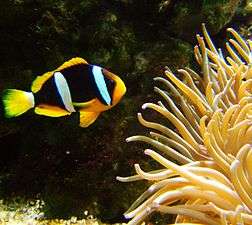
A. clarkii (Clark's anemonefish)
-
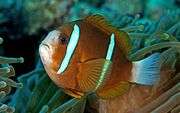
A. akindynos (Barrier Reef anemonefish)
-

A. allardi (Allard's anemonefish).
-

A. bicinctus (Two-band anemonefish)
-
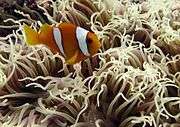
A. chagosensis (Chagos anemonefish)
-

A. chrysogaster (Mauritian anemonefish)
-

A. chrysopterus (Orange-fin anemonefish), Palau
-
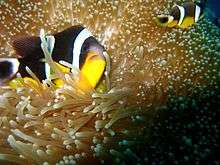
A. fuscocaudatus (Seychelles anemonefish)
-
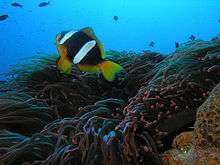
A. latifasciatus (Madagascar anemonefish)
-
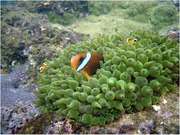
A. omanensis (Oman anemonefish)
Tomato complex
-
.jpg)
A. ephippium (Red Saddleback anemonefish)
-
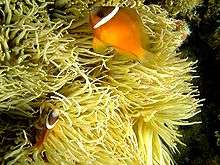
A. barberi (Barber's anemonefish)
-

A. frenatus (Tomato anemonefish)
-
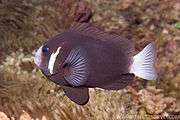
A. mccullochi (Whitesnout anemonefish)
-

A. melanopus (Red & Black anemonefish)
-

A. rubrocinctus (Australian anemonefish)
Saddleback complex
-

A. latezonatus (Wide-band anemonefish)
-
A. polymnus (Saddleback anemonefish) off Sulawesi, Indonesia
-
A. sebae (Sebae anemonefish)
Skunk complex
-
A. akallopisos (Skunk anemonefish)
-
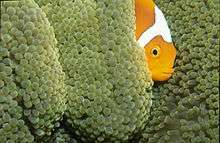
A. leucokranos (White-bonnet anemonefish)
-
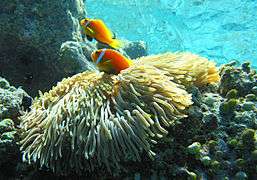
A. nigripes (Maldive anemonefish)
-

A. perideraion (Pink skunk anemonefish)
-

A. sandaracinos (Orange anemonefish)
Premnas biaculeatus
-

P. biaculeatus (Maroon anemonefish)
Notes
References
- ↑ http://animals.nationalgeographic.com/animals/fish/clown-anemonefish/#
- 1 2 Fautin, Daphne G.; Allen, Gerald R. (1997). Field Guide to Anemone Fishes and Their Host Sea Anemones. Western Australian Museum. ISBN 9780730983651. Archived from the original on 14 April 2015.
- 1 2 Porat, D.; Chadwick-Furman, N.E. (2005). "Effects of anemonefish on giant sea anemones: Ammonium uptake, zooxanthella content and tissue regeneration" (PDF). Marine and Freshwater Behaviour and Physiology. 29 (1): 43–51. doi:10.1080/10236240500057929. Retrieved 18 April 2013.
- ↑ Fautin, D.G.; Guo, C.; Hwang, J.S. (1995). "Costs and benefits of the symbiosis between the anemoneshrimp Periclimenes brevicarpalis and its host Entacmaea quadricolor.". Marine Ecology Progress Series. 129: 77–84. doi:10.3354/meps129077.
- 1 2 "Clown Anemonefish". Nat Geo Wild : Animals. National Geographic Society. Retrieved 2011-12-19.
- ↑ Amphiprioninae at the Encyclopedia of Life
- ↑ Holbrook, S. J. and Schmitt,R. J. Growth, reproduction and survival of a tropical sea anemone (Actiniaria): benefits of hosting anemonefish, 2005, cited in
- ↑ "Clown Anemonefishes, Amphiprion ocellaris". Marinebio. The MarineBio Conservation Society. Retrieved 2011-12-19.
- ↑ Szczebak, Joseph T.; Raymond P. Henry; Fuad A. Al-Horani; Nanette E. Chadwick (2013). "Anemonefish oxygenate their anemone hosts at night". Journal of Experimental Biology. 216 (9): 970–976. doi:10.1242/jeb.075648.
- ↑ Joseph T. Szczebak; Raymond P. Henry; Fuad A. Al-Horani; Nanette E. Chadwick (2012-11-03). "Anemonefish oxygenate their anemone hosts at night". The Journal of Experimental Biology. Retrieved 2013-09-15.
- ↑ Mebs, D. 1994. "Anemonefish symbiosis: Vulnerability and Resistance of Fish to the Toxin of the Sea Anemone." Toxicon. Vol. 32(9):1059–1068.
- ↑ Lieske, E.; and R. Myers (1999). Coral Reef Fishes. ISBN 0-691-00481-1
- ↑ Debelius, H. (1997). Mediterranean and Atlantic Fish Guide. ISBN 978-3925919541
- ↑ Fretwell, K.; and B. Starzomski (2014). Painted greenling. Biodiversity of the Central Coast. Retrieved 29 January 2015.
- ↑ Clownfish Breeding for Beginners by Jeff Hesketh of Mad Hatter's Reef
- ↑ Stephanie Boyer. "Clown Anemofish". Florida Museum of Natural History. Retrieved 2013-09-15.
- 1 2 Robert M. Ross (1978-02-10). "Reproductive Behavior of the Anemonefish Amphiprion melanopus on Guam" (PDF). Copeia. Retrieved 2013-09-15.
- ↑ Peter Buston (2004-08-18). "Does the presence of non-breeders enhance the fitness of breeders? An experimental analysis in the clown anemonefish Amphiprion percula" (PDF). Springer-Verlag. Retrieved 2013-09-15.
- ↑ Swagat Ghosh; T. T. Ajith Kumar; T. Balasubramanian (2011-08-04). "Determining the level of parental care relating fanning behavior of five species of clownfishes in captivity" (PDF). Indian Journal of Geo-Marine Sciences. Retrieved 2013-09-15.
- ↑ Dhaneesh, K.V.; R. Vinoth; Swagat Gosh; M. Gopi; T.T. Ajith Kumar; T. Balasubramanian (2013). Sundaresan, J., ed. "Hatchery Production of Marine Ornamental Fishes: An Alternate Livelihood Option for the Island Community at Lakshadweep". Climate Change and Island and Coastal Vulnerability. Capital Publishing Company. 17: 253–265. doi:10.1007/978-94-007-6016-5_17.
- ↑ Taylor, M., Green, E. and Razak, T. (2003). From ocean to aquarium: A global trade in marine ornamental species (PDF). UNEP world conservation and monitoring centre (WCMC). pp. 1–64. Retrieved 18 April 2013.
- ↑ Shuman, Craig; Gregor Hodgson; Richard F. Ambrose (2005). "Population impacts of collecting sea anemones and anemonefish for the marine aquarium trade in the Philippines". Coral Reefs. 24: 564–573. doi:10.1007/s00338-005-0027-z.
- ↑ Watson, Craig; Jeffery Hill (2006). "Design criteria for recirculating, marine ornamental production systems". Aquacultural Engineering. 34 (3): 157–162. doi:10.1016/j.aquaeng.2005.07.002.
- ↑ Hall, Heather; Douglas Warmolts (2003). "23". In James C. Cato, Christopher L. Brown. Marine Ornamental Species: Collection, Culture and Conservation. Wiley-Blackwell. pp. 303–326. ISBN 978-0-8138-2987-6.
- ↑ Tullock, John (1998). Clownfish and Sea Anemones (illustrated ed.). Barron's Educational Series. pp. 11–22. Retrieved 2015-05-11.
- ↑ Daphne Gail Fautin (1991). "The anemonefish symbiosis: what is known and what is not" (PDF). Symbiosis. 10: 23–46. Archived from the original (PDF) on 2012-05-25.
- ↑ Ronald L. Shimek (2004). Marine Invertebrates. Neptune City, NJ: T.F.H. Publications. p. 83. ISBN 978-1-890087-66-1.
- ↑ Goemans, B. "Anemonefishes". Retrieved 20 September 2015.
- 1 2 3 Litsios, G.; Salamin, N. (2014). "Hybridisation and diversification in the adaptive radiation of clownfishes". BMC Evolutionary Biology (14): 245. doi:10.1186/s12862-014-0245-5.
- 1 2 DeAngelis, R. "What we really know about the diversity of Clownfish". Retrieved 20 September 2015.
- 1 2 Litsios, G.; Sims, C; Wüest, R; Pearman P.B.; Zimmermann, N.E.; Salamin N. (2012). "Mutualism with sea anemones triggered the adaptive radiation of clownfishes". BMC Evolutionary Biology (11): 212. doi:10.1186/1471-2148-12-212.
- ↑ van der Meer M.H.; G.P. Jones; J-P.A. Hobbs; L. van Herwerden (2012). "Historic hybridization and introgression between two iconic Australian anemonefish and contemporary patterns of population connectivity". Ecology and Evolution. 2 (7): 1592–1604. doi:10.1002/ece3.251.
- ↑ Froese, Rainer, and Daniel Pauly, eds. (2011). Species of Amphiprion in FishBase. December 2011 version.
- ↑ Froese, Rainer, and Daniel Pauly, eds. (2011). Species of Premnas in FishBase. December 2011 version.
- ↑ "Finding Nemo (2003)". Retrieved 5 April 2016.
External links
| Wikimedia Commons has media related to Amphiprioninae. |
| Wikispecies has information related to: Amphiprioninae |
- Clownfish species profiles on AquariumDomain.
- (German) Photo Gallery of Amphiprion ocellaris and their eggs
- Monterey Bay Aquarium: Video and information
- Clown Fish underwater photography gallery
- Aquaticcommunity.com
- Tolweb.org